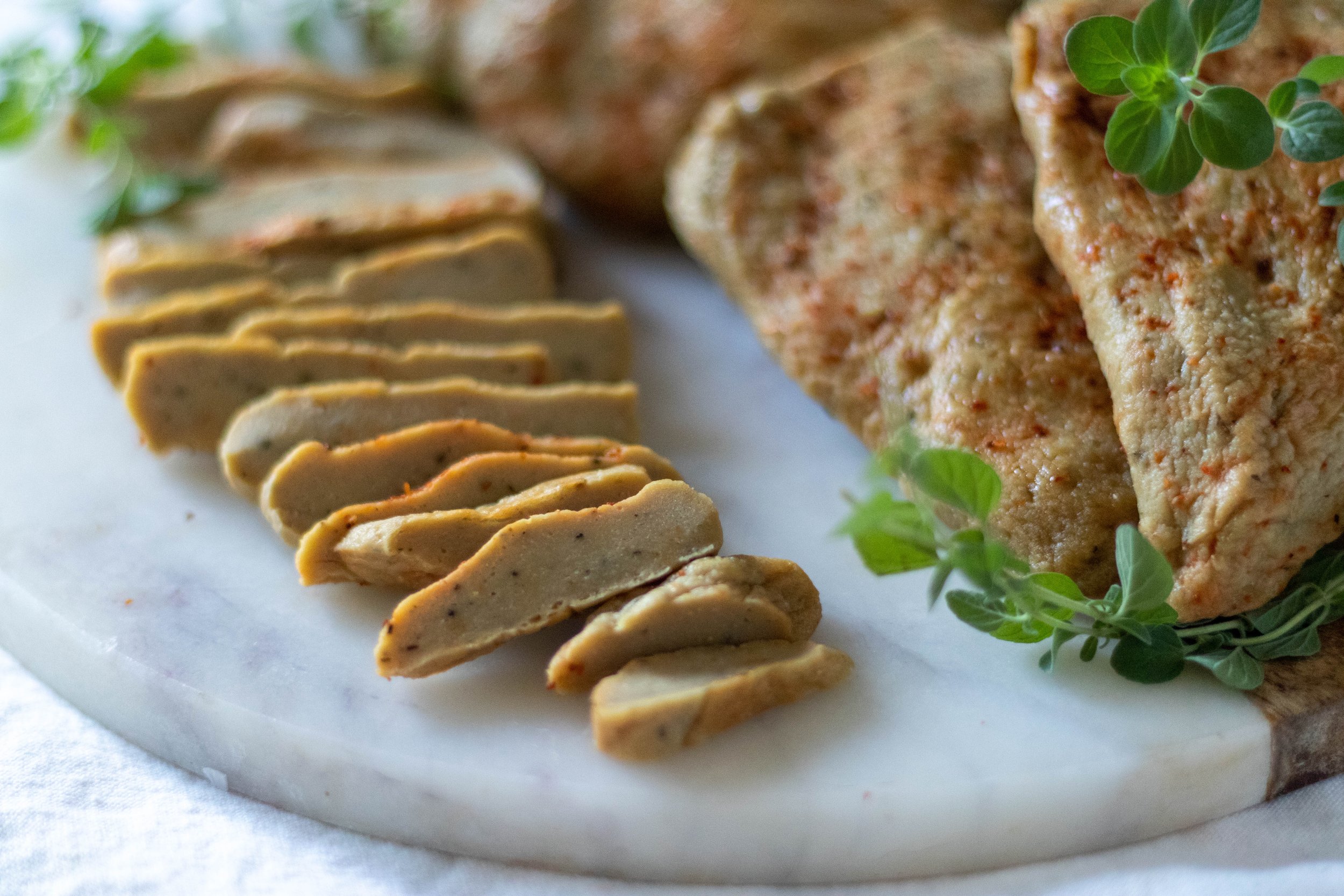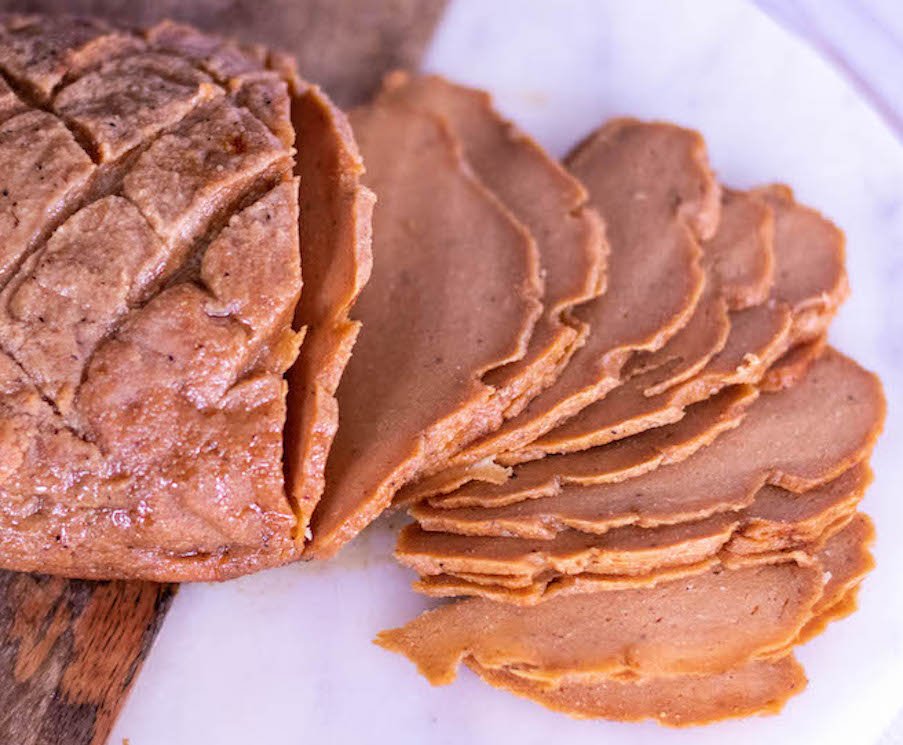Of all of my recipes, the ones I get the most questions about are my seitan recipes.
This is actually not that surprising. Making your own seitan can seem overwhelming, and intimidating, but it really is a pretty simple thing you can make right at home. Don’t get me started on the money you can save making homemade seitan. I try my best to help and encourage anyone who wants to give setian making a whirl, and remind you that it really is easier than it may seem at first!
That said, I still get a lot of questions about substituting ingredients, and troubleshooting some things that can go wrong when making your own seitan roasts, chicken breast , steaks, or lunch meats.
So i decided to compile a list of my most asked questions on seitan in hopes of helping y’all troubleshoot and and successfully make your own seitan at home . All in one place, so you have the info you need when you need it.
WHY IS MY SEITAN FULL OF LITTLE HOLES, IT LOOKS LIKE BREAD:
This is the question I get most often. Your seitan should be nice and smooth on the inside, not full of holes or looking like a loaf of bread. This issue is addressed in almost all of my recipes in BOLD print, but somehow still often gets missed, so let’s get it out of the way first. This is most likely due to your oven cooking at a higher temperature than what your oven is set to. This is a common issue, and the best way to know the true oven temperature is getting an external oven thermometer. This way you will know exactly what you are dealing with. If you don’t have one, or don’t want to buy one, my advice is to bump your oven temperature down 25 degrees and keep the seitan covered the majority of the baking time. This obviously only applies to baked seitan, as some of my recipes are not baked, but simmered. You can remove the foil the last 10 minutes for a larger seitan, like the deli meats, or the last 5 minutes for the chicken breast or pork chops.
DOES IT REALLY HAVE TO REST:
Unless I state otherwise in a recipe, you better LET IT REST. I often have people message me that the texture of their setian is off/gummy/soft or anything but right, and most of time it is because they did not let it rest. Seitan, much like myself, appreciates a nice long nap. If you don’t let it rest, do not expect the texture to be what you are wanting. It’s just science, and fact, and the golden rule of seitan. GIVE IT A REST!
MY SEITAN FORMED A BUBBLE WHILE BAKING AND IT DEFLATED INTO A WEIRD SKIN:
You more than likely did not wrap the roast tightly enough in foil. Next time double wrap it and make sure its wrapped really well. If there is room for it to expand and create an air pocket, it will. Not to worry, it will deflate as it cools, and it will be totally edible and tasty. But if you want a nice pretty roast, wrap it up real tight!
I DON’T LIKE TO USE ALUMINUM FOIL, WHAT ELSE CAN I USE:
I always suggest foil. It is the only way to get it nice and tightly wrapped and get a good steam in the oven. I suggest if you don’t want the foil touching the food, to first wrap it in parchment paper then foil. The foil can be reused many times to avoid waste.
I CAN’T FIND SUPER FIRM/HIGH PROTEIN TOFU WHERE I LIVE:
Extra firm will work. You just need to press it and remove as much liquid as you can. Firm and silken are not advised as they hold much more water, and the texture is so much softer. I often hear that when people have tried those tofus, it yields a very soft or gummy roast. If you can’t find super or extra firm tofu, I address that further down in this post.
I DON’T EAT/HAVE TOFU, JACKFRUIT, BEANS. WHAT CAN I USE INSTEAD:
If you can’t eat soy, or cannot find the tofu I use in most of my recipes, you can always use a 20 oz can of jackfruit in brine, drained and rinsed instead. You can also use a can of drained and rinsed chickpeas. As a mater of fact, I have recipes on the site using all of the above. My crispy skin turkey roast is made with jackfruit, my crispy skin chicken is made with chickpeas, and my brisket is made with jackfruit. These ingredients can be swapped between recipes pretty easily. You may just need to add a few tablespoons more VWG or add a tad more liquid as some recipes have a bit more or less of either ingredient. But most people have had great luck swapping these ingredients out.
I CAN’T FIND THE SPICE RUB YOU USED IN THE RECIPE:
Use literally any spice blend you like. I often get asked about a hickory rub I used on the turkey. You can always make your own spice blends if you can’t find them already blended! Google away my friends, there is a recipe for just about any season blend you want out there!
MY SEITAN IS GUMMY/SOFT AFTER THE FULL BAKE TIME:
First and foremost, did you let it rest?!?!?! If you did, it is likely that there was too much liquid in the dough. You can watch this video on the 86easts deli turkey to see what your dough in most of the 86eats seitan roasts should look like. A too wet, too soft dough is going to make a gummy, soft seitan. This could be because you used a tofu that was not super firm, or not pressed well enough so it was holding extra liquid. Or if there was water suggested in the recipe, you did not wait to add it until the end. This is suggested because depending on the tofu used you may or may not need all of the water in the recipe. Watch the video to get a good idea of what the dough should look like! Another reason this could have happened was your oven is not cooking as hot as you think. Just like it cooking too hot and making holes in your seitan, the opposite could be true. This is why I suggest even a cheap oven thermometer to see what temperature your oven is really baking at.
IT WAS GOOD BUT TOO SALTY/NOT ENOUGH SEASONING:
I am gonna try and say this nicely….ADD LESS SALT NEXT TIME, OR ADD MORE SEASONING NEXT TIME. You can decide all by yourself how much salt or seasoning you like. The whole saying “salt to taste!” I am not as liberal with salt and seasonings in my recipes as I am when I am cooking for myself. I have been given many an internet talking to about my recipes being too salty, so now days I write my salt instructions with caution. But you are free to salt and season however your little heart desires, and if a seasoning ingredient amount gives you pause on my site, use less, or more, whichever way you are leaning.
I DON’T HAVE A FOOD PROCESSOR, CAN I USE A BLENDER:
If you are making one of the seitan recipes with tofu, you need to get that tofu broken down. You can not mix the dough in a blender, not even a vitamix, because it will burn the motor out. You CAN mix the tofu and any wet ingredients in any blender you have until it is smooth and creamy, then either finish up mixing and kneading by hand, or using a bread hook attachment in a stand mixer.
I AM OIL FREE, CAN I LEAVE OUT THE OIL IN A SEITAN RECIPES:
You sure can. But since it is a liquid ingredient, you just need to replace it with and equal amount of liquid, like water or veggie broth.
HOW DO I REHEAT MY ROAST AFTER IT HAS RESTED:
As we talked about in the beginning, you have to let it rest. So you are going to want to reheat the seitan unless you are using it for deli meat. I suggest covering roasts again in foil and reheating in the oven covered until heated through. If I am serving as slices, I will slice then reheat covered in foil just because it is faster. Once seitan has rested you can bake, fry, saute, grill, or do whatever you like with your seitan. I often fry my easy chicken breast, and always grill my hotdogs.
CAN I ADD CRISPY RICE SKIN TO ANY OF THE ROAST:
Yes you can. If you prefer the tofu turkey to the jackfruit turkey, just slap that rice paper skin on the one you like. Just follow the instructions for the roast you like then add this skin as follows:
RICE PAPER SKIN:
2 tablespoons white wine
3 tablespoons water
2 teaspoons Herbs de Provence
1 teaspoon Vegetable Better than Bouillon
3 sheets rice paper
Add all of the ingredients for the rice paper skin, except the rice paper, to a shallow dish or pie pan and whisk. Place one sheet of rice paper into the liquid and let it sit there until it becomes completely soft. This takes several minutes. Gently lift the rice paper from the dish and place it in the middle of the foil. Place the roast on top of the paper and fold the edges of the rice paper up around the roast. Continue with the other 2 pieces of rice paper just the same as the first, draping each one over the top of the roast and tucking or pressing the edges of the paper around the roast. The paper should be very soft and sticky, and cling well to the roast.
Fold up the sides of the foil making a pouch, pinching the foil together well along the top to form a tight seal. Then twist the ends of the foil. Place the pouch on a baking sheet in the oven on the top rack. Allow the roast to bake in the sealed pouch for half an hour. After half an hour, carefully remove the roast from the oven and open the pouch, making sure the tops and sides of the roast are exposed. If you sprayed the foil well the rice paper should not be sticking too badly to the foil. If it is, gently pull it away form the foil and push torn rice paper back into the roast. Give the top of the roast a spray of oil or light brushing and return it to the oven for another 40 minutes.
CAN I FREEZE MY SEITAN:
Your seitan can be frozen in an airtight container or freezer bag for up to 6 months. I just thaw mine out on the counter or in the fridge. Your seitan should keep in the fridge in an air tight container for about 10 days. You can freeze a seitan roast whole, but if I am using it for deli slices, I slice then freeze, or cut into quarter just so it thaws faster.
HOW CAN I STUFF MY SEITAN ROAST:
I have several stuffed seitan turkey recipes, but if you want to use a different stuffing, go right ahead. Just make whatever stuffing you like then follow instructions on my recipes for stuffing and rolling your roast for a nice, pretty, even bake.
I am sure I have missed some questions and tips and will certainly come back and update as they arise, but for now this should help you out not only on 86eats seitan recipes, but most Vital Wheat Gluten based seitans. I have tired to keep my seitan recipes pretty simple, and beginner to intermediate level. I want everyone who has the ability and desire to try and make their own homemade seitan to not feel intimidated and overwhelmed, but confident that this is something they can do at home pretty easily and pretty inexpensively!
Good luck and remember, LET IT REST FOR THE GOOD LOVE!!!































